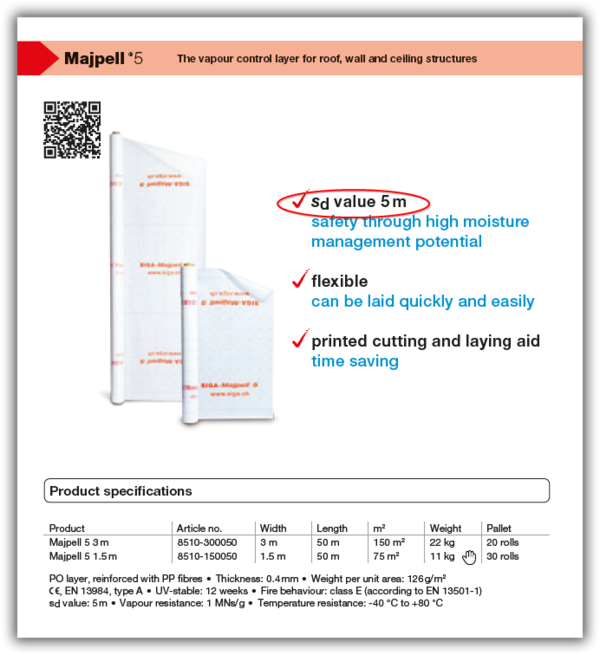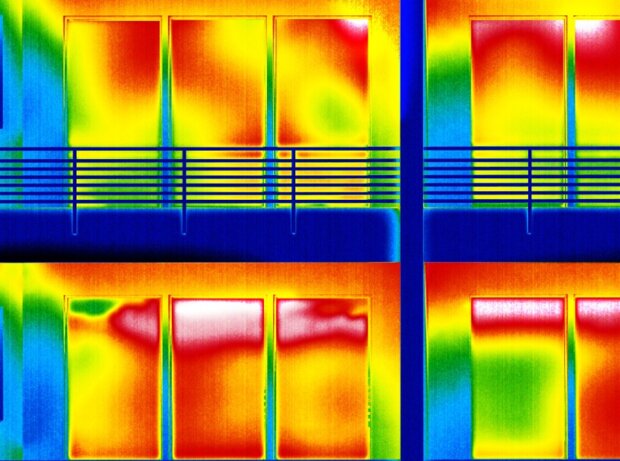
What is an Sd value?
A plain-language description of the measure of resistance to water vapour, the Sd value. Useful for designers of low energy high efficiency buildings.
The Sd value is the resistance to movement of water vapour, when compared to the resistance of a meter of air.
Naturally water vapour will flow by diffusion from an area of high vapour pressure to low. The medium it is travelling in will resist that movement, be it:
- Air,
- A certain thickness of solid material such as insulation, or
- A sheet, membrane or tape
The Sd value is simply a measure of how much resistance to moisture diffusion the medium has, when compared to a meter of air. The unit of measurement is meters.
It may also be known as “Diffusion-equivalent air layer thickness”, or simply “Equivalent air layer thickness.”
A high Sd value is 200m (e.g. aluminium foil). A low value is 0.1m (e.g. breather membrane).
Why do you need to know this?
Any designer, specifier or builder of a high comfort, efficient building needs to be aware of moisture risks and how to control them.
The principles of moisture-safe construction rely on an understanding on how moisture will move in the building fabric; in summer and in winter. If we place a material with a high Sd value, such as foil, on the cold side of the insulation, condensation may form.
This is exactly what you are witnessing when condensation forms on a window in winter. The glass has a very high Sd value, as its impermeable.
When this happens hidden in the wall, it can lead to all sorts of problems such as
- Mould growth
- Structural damage
- Staining
- Corrosion
- Higher heat loss
- Lower comfort etc
Knowing the Sd value allows you to select the right membrane for the right application.
Generally, a lower Sd value is desirable to achieve a ‘breathable’ fabric. The golden rule is this:
The construction to the cold side of the insulation needs to be 5 times less resistant to moisture movement than the layer on the warm side.
This means that moisture cannot get trapped in the insulation zone where it will cause mischief.
Every SIGA tape has an Sd value published, so you can be sure they are vapour permeable when they need to be & vice versa.
When do we use Sd values?
At the design stage, specifiers can select the right product for the task. Designers can compare manufacturer’s products to determine the most suitable. If a product is substituted later on, be sure to match the Sd value.
Where do we find the Sd value?
The Sd value will be listed in the product datasheet provided by the manufacturer. In SIGA’s case it is on the product webpage, as shown below.

The Sd-value of SIGA's Majpell® 25 is 25m...
Sd values are also listed in the manual in the “Downloads” section off the main SIGA webpage.

…whereas the Sd value of SIGA’s Majpell® 5 is 5m
How to convert Sd value units
- Annex E of “BS 5250 Code of practice for control of condensation in buildings”
gives typical values and covers the main concepts - If you know the vapour resistance factor µ mu (no units) of a build up or material, multiply by the thickness to get Sd (m).
- E.g.200mm mineral fibre has a µ of 1 and an Sd of 0.2m
- If you know the vapour resistance of a membrane (MN.s/g) multiply by 0.2 g.m/MN.s to get Sd (m).
- E.g. Majpell® 5 has vapour resistance of 25M.N.s/g and an Sd of 5m
- If you know the vapour resistivity of a material (MN.s/g.m) multiply by 0.2 g.m/MN.s & multiply by the thickness (m) to get Sd (m)
- E.g. 13mm Plasterboard has a vapour resitivity of 60 MN.s/g.m and an Sd value of 0.16m
- 0.2 g.m/MN.s is the vapour permeability of still air
- This page contains useful summary of units and conversions
Variable Sd & the reason for intelligent membranes
To make things more interesting, in some materials these values change with varying conditions. In fact, manufacturers take advantage of this to develop ‘intelligent’ membranes. These products have variable vapour resistance, Sd, depending on humidity and direction of movement.
Summary
The Sd value is a relative value of resistance to moisture movement. Make sure you seek out the moisture resistance of each product you are specifying, and apply it accordingly. Don’t specify a membrane or tape without ensuring it is fit for the job.
PS: You want to learn more about how to build airtight? Register now for an educational workshop and earn RIBA credits (UK) or RIAI credits (Ireland) by attending one of our airtightness CPD workshops.

Bertie Dixon
Bertie has practised building services engineering and sustainability consulting in the UK for 15 years. He is a certified PassivHaus planner. He is on a mission to help you deliver a high-quality building, one that does what it says on the tin.










